The Banksia is a plant that most Australians are familiar with. There are story books written about Banksias by an Author and Artist named May Gibbs, with characters like Snugglepot and Cuddlepie and the big bad Banksia men. I used to read this book when i was a young. May Gibbs' house ( Nutcote ) is situated in the North Sydney area, and now she has passed away, it is a heritage listed education centre and museum dedicated to her work.
Banksias are a group of plants containing many species. They range from 15 metre trees to short shrubs or groundcover varieties, and there is one for most garden situations. Some will tolerate boggy or swamp like conditions, and others prefer rocky well drained soil on the sides of cliffs or on the coast where they endure salt spray. The one thing Banksias have in common is the shape of the flowers.... they have a distinctive candle - like shape, and the colours can vary from creamy white to reds and orange and yellow tones. Banksias are sometimes called Australian Honeysuckles, because the flowers produce an abundance of nectar that the birds- especially native Parrots- love.
Some common species of Banksia around Sydney are Banksia intergifolia, and Banksia ( Coast Banksia ) and Banksia serrata ( Old Man Banksia ). Plant breeders have released lots of really nice small growing varieties of the plant which are available in nurseries and garden centres.
I photographed these Banksias in a Sydney waterfront reserve.

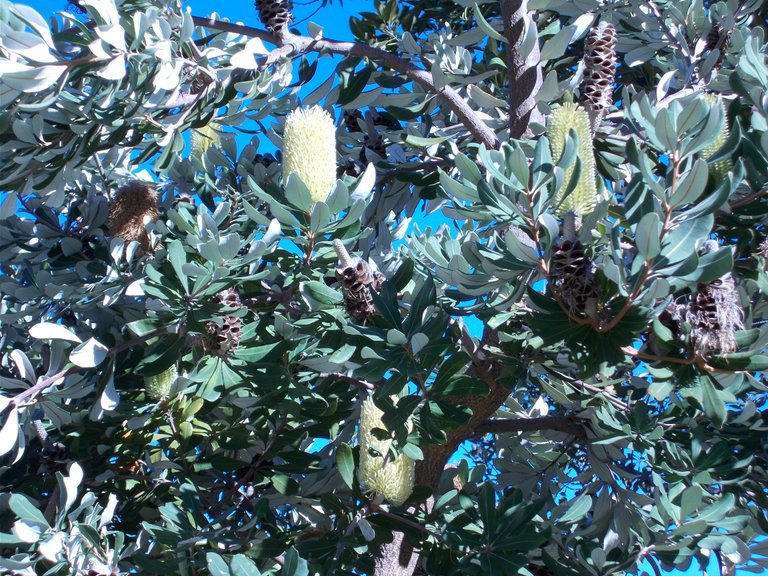
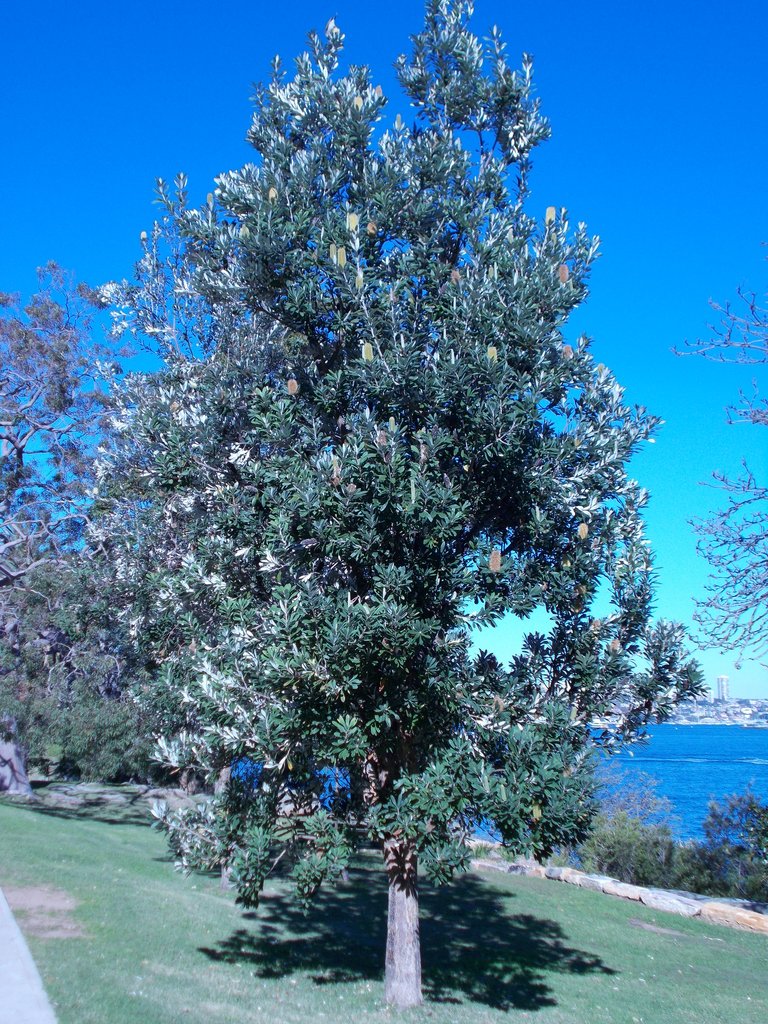
Banksia plants belong to a genus of around 170 species native to Australia. They also belong to the Proteaceae plant family, which is an ancient family of flowering plants that dispersed and diversified throughout Gondwana before the supercontinent disintegrated.
With about 1600 species, Proteaceae is one of the plant groups that dominate the southern hemisphere flora. Banksia plants take many forms, from trees up to 30 meters tall, to woody shrubs, to a few prostrate species.
The leaves vary greatly between species, with sizes varying from 1.0–1.5 centimeters long up to 45cm long. The young leaves are velvety and often brownish or yellow in color, while the mature leaves are green or dark green, hard to touch and most species have serrated edges.
Leaves are usually arranged along the branches in irregular spirals, but in some species, they are crowded together in whorls. The most distinguishing feature of banksias is the flower spike, which is an elongated inflorescence consisting of a woody axis covered in tightly-packed pairs of flowers attached at right angles.
A single flower spike generally contains hundreds or even thousands of flowers; the most recorded is around 6000 inflorescences in Banksia grandis.
Source
Fav.comment Award !! Well done, you chose great Pics and included nice information too.
Australia, an island continent isolated by oceans from the rest of the world, has stunning biodiversity of plants. In 1770, Captain Cook and Sir Joseph Banks, his botanist on board the Endeavor, were the first white men to land at "Botany Bay" (Cook's name), and discovered a plant with spikes of golden flowers appearing like ripe ears of corn or bronzed pinecones. Cook, a master navigator and labeler of newly discovered lands and seas, named Banksia after the 26-year-old botanist.
The flower spikes of Banksias are terminal and consist of thousands of individual flowers in pairs around a central woody cone. The brilliant golden-orange styles of River Banksia flare out with soft curved hooks from the woody axis. Sunbirds, with long beaks, can sip out the rich nectar contained deep within them. Old cones from years past perch on the branches, and the winged seeds embedded in the ovaries can remain on the cone indefinitely until the heat of a wildfire forces them open.
Along the southwestern and southeastern coastal areas of Australia are close to 76 species of Banksia with a great variety of leaves and growth habits. From prostrate ground growers, to shrubs, to trees with irregular trunks, Banksia are quite differentiated. A few species are also found in southern New Guinea. River Banksia is a small tree with long slender serrated leaves with pale undersides. The flowers are a magnificent red-gold.
Fav. comment Award !! Great Pics and Information. Thanks.
Thank you so much dear @ctrl-alt-nwo
Banksias have special roots called proteoid roots which help them to grow in our low nutrient Australian soils. As such they require little fertilising and are particularly sensitive to high levels of phosphorous, especially when they are young. Once or twice a year apply a certified organic fertiliser which is labeled safe for natives or has a phosphorus content less than 2%.
There are more than 170 species of banksias with all but one being endemic to Australia and they range from ground covers to tall trees. Flowers are yellow, orange, pink and red and many have beautiful serrated leaves.
Probably the most common species grown in the home garden are Banksia spinulosa, Banksia speciosa and Banksia ericifolia while the cultivars ‘Giant Candles’ and ‘Birthday Candles’ are also popular with their prolific flowering.
Generally banksias require little pruning. Simply trim off any dead branches which may appear and prune back to restrict the size/shape if needed.
Source
Silly Sausage Award !! Great Pics and information, thanks.
Source
Banksias are named in honour of botanist Sir Joseph Banks and are popular Australian natives due to their impressive flower spikes consisting of hundreds of smaller flowers.
The nectar laden flowers are perfect for attracting bees and birds into your garden plus they also make great cut flowers indoors where they’ll release their honey scent.
Source
There are more than 170 species of banksias with all but one being endemic to Australia and they range from ground covers to tall trees. Flowers are yellow, orange, pink and red and many have beautiful serrated leaves.
Source
Probably the most common species grown in the home garden are Banksia spinulosa, Banksia speciosa and Banksia ericifolia while the cultivars ‘Giant Candles’ and ‘Birthday Candles’ are also popular with their prolific flowering.
Source
Source
Text Source
The flower heads are made up of hundreds (sometimes thousands) of tiny individual flowers grouped together in pairs. The colour of the flower heads usually ranges from yellow to red. Many species flower over autumn and winter.
The fruits of banksias (called follicles) are hard and woody and are often grouped together to resemble cones (which they are not true cones are produced only by conifers).
The fruits protect the seeds from foraging animals and from fire. In many species the fruits will not open until they have been burnt or completely dried out.
South western Australia contains the greatest diversity of banksias, with 60 species recorded. They are also an important part of the flora of Australia's eastern coast. Few banksias are found in the arid regions of Australia or in the rainforests of the eastern coast.
There are no species which are common to eastern and western Australia except Tropical Banksia, Banksia dentata , which occurs across northern Australia, in Papua New Guinea, Irian Jaya and the Aru Islands.
Source: https://www.anbg.gov.au/banksia/
To improve soils to banksia-friendly condition, add gypsum or other soil conditioner or raise the soil level into a mound at least 30-60 cm above the pre-existing level. Banksias appreciate extra water during dry periods, especially during summer. Special care should be taken not to let them dry out until established. They will eventually put roots deep into the ground and find the water table, but the process may take up to two years.
Fertilising with phosphorus should be minimal. A slow-release, low-phosphorous treatment is best. If new leaves turn yellow use iron chelate or iron sulphate according to the instructions. Species that grow from lignotubers, a group that includes Banksia robur, B. spinulosa and B. serrata, may be pruned hard - even back to ground level. Others, including B. ericifolia and B. ‘Giant Candles’ are nonlignotuberous and should be pruned lightly (not below green foliage) after each flush of flowers. This prolongs the life of the plants and keeps them compact.
https://www.gardenclinic.com.au/how-to-grow-article/banksia?pid=44203
Banksia is a member of the protea (Proteaceae) family and is a genus of around 75 species of evergreen shrubs and trees that feature attractive foliage, bold flowering spikes, and interesting fruiting cones. These woody low-growing shrubs to low-branching trees are endemic to Australia, with just one species, Banksia dentata, extending from northern Australia to New Guinea. The genus is named for Sir Joseph Banks (17431820), the renowned English botanist who first documented the plants on his travels around Australia with Captain Cook, and who was one of the founders of the Royal Horticultural Society.
Banksias vary from prostrate shrubs to low-branching trees. They are sturdy plants, often with a stout trunk. Typically they have long, leathery, coarsely toothed leaves, though a few species have finer or more needle-like foliage. Cylindrical or globular spikes are densely packed with hundreds of small flowers. The individual thread-like blooms are long lasting and nectar-rich. As the flowers die they develop into large, woody, fruiting cones. Flowering time varies, depending on the species.
http://www.abc.net.au/gardening/plant-finder/banksia/9441934
Banksias are named in honour of botanist Sir Joseph Banks and are popular Australian natives due to their impressive flower spikes consisting of hundreds of smaller flowers. The nectar laden flowers are perfect for attracting bees and birds into your garden plus they also make great cut flowers indoors where they’ll release their honey scent.
Banksias also produce very distinctive woody seed pods which you’ll instantly recognise as the big bad Banksia men if you’ve read the children’s book “Snugglepot & Cuddlepie” by May Gibbs.
There are more than 170 species of banksias with all but one being endemic to Australia and they range from ground covers to tall trees. Flowers are yellow, orange, pink and red and many have beautiful serrated leaves.
Source
Wow this is the first time I heard about the name of this plant, but probably I saw this plant in Animal Planet or other nature TV series before! But this is the very first time I could know more about this plant! Really appreciate your information and nice photography as well!@ctrl-alt-nwo,
Cheers~
Banksia is commonly known as Australian honeysuckles, are a genus of around 170 species in the plant family Proteaceae. These Australian wildflowers and popular garden plants are easily recognised by their characteristic flower spikes and fruiting "cones" and heads. Banksias range in size from prostrate woody shrubs to trees up to 30 metres tall. They are found in a wide variety of landscapes; sclerophyll forest, (occasionally) rainforest, shrubland, and some more arid landscapes, though not in Australia's deserts.
Source
Source
Source
Source
Source
Thank you so much sir @ctrl-alt-nwo for always sharing beautiful Australian plants.
Thank you for posting @ctrl-alt-nwo.
Appreciate these lovely photographs......of this beautiful tree.
Will it still be bloom at Christ-mas time.....for the blooms come across as candles in a fantastic way.
All the best to you.
Cheers!
Striking and attractive Australian native plants with thick, often serrated leaves and large erect cones of stiff, wiry flowers in shades of greenish-white, yellow and orange through to red. Banksias range from ground covers, low growing shrubs to small trees and are great plants to attract bees and nectar feeding birds to the garden.
Choose a sunny spot with well drained soil. Enrich the soil with Yates Dynamic Lifter Soil Improver & Plant Fertiliser. If the soil is heavy clay based or poorly drained, add gypsum and fork in well to improve drainage and consider planting into a raised mound of well drained soil.
https://www.yates.com.au/autumn/autumn-flowers/how-to-grow-banksia/
Woops, the first to Pics are Callistemon, not Banksias, no problems , they look a bit similar !
Thank to the correction.
Banksia, commonly known as Australian honeysuckles, are a genus of around 170 species in the plant family Proteaceae. These Australian wildflowers and popular garden plants are easily recognised by their characteristic flower spikes and fruiting "cones" and heads. Banksias range in size from prostrate woody shrubs to trees up to 30 metres tall. They are found in a wide variety of landscapes; sclerophyll forest, (occasionally) rainforest, shrubland, and some more arid landscapes, though not in Australia's deserts.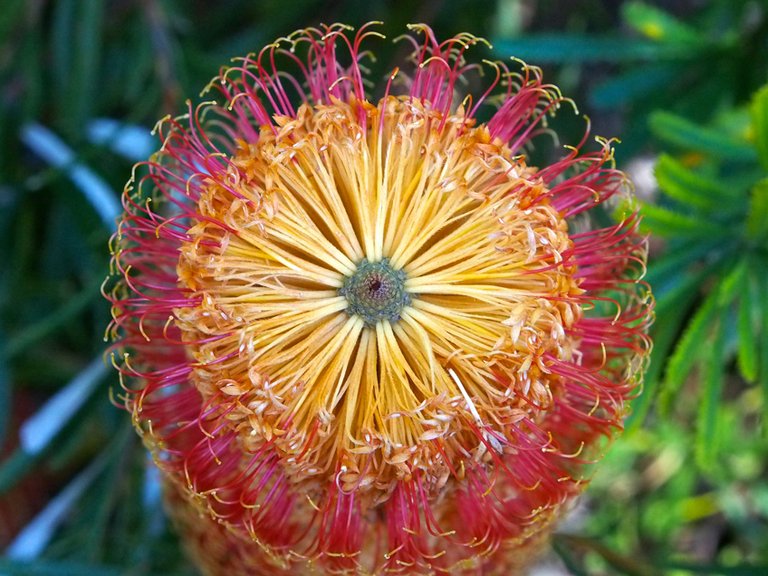 Heavy producers of nectar, banksias are a vital part of the food chain in the Australian bush. They are an important food source for all sorts of nectarivorous animals, including birds, bats, rats, possums, stingless bees and a host of invertebrates. Furthermore, they are of economic importance to Australia's nursery and cut flower industries. However these plants are threatened by a number of processes including land clearing, frequent burning and disease, and a number of species are rare and endangered.
Heavy producers of nectar, banksias are a vital part of the food chain in the Australian bush. They are an important food source for all sorts of nectarivorous animals, including birds, bats, rats, possums, stingless bees and a host of invertebrates. Furthermore, they are of economic importance to Australia's nursery and cut flower industries. However these plants are threatened by a number of processes including land clearing, frequent burning and disease, and a number of species are rare and endangered.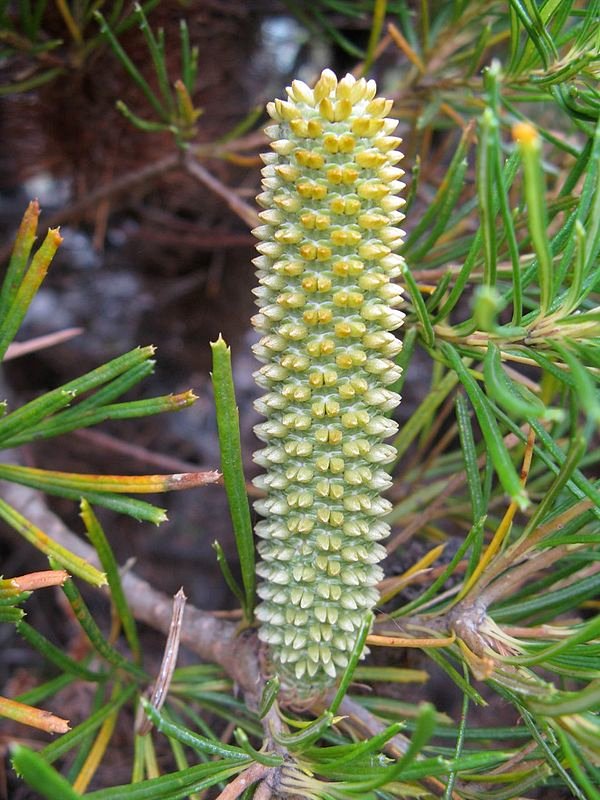 Banksias grow as trees or woody shrubs. Trees of the largest species, B. integrifolia (coast banksia) and B. seminuda (river banksia), often grow over 15 metres tall, some even grow to standing 30 metres tall.[1] Banksia species that grow as shrubs are usually erect, but there are several species that are prostrate, with branches that grow on or below the soil.
Banksias grow as trees or woody shrubs. Trees of the largest species, B. integrifolia (coast banksia) and B. seminuda (river banksia), often grow over 15 metres tall, some even grow to standing 30 metres tall.[1] Banksia species that grow as shrubs are usually erect, but there are several species that are prostrate, with branches that grow on or below the soil.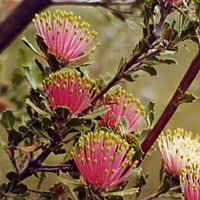 The leaves of Banksia vary greatly between species. Sizes vary from the narrow, 1–1½ centimetre long needle-like leaves of B. ericifolia (heath-leaved banksia), to the very large leaves of B. grandis (bull banksia), which may be up to 45 centimetres long. The leaves of most species have serrated edges, but a few, such as B. integrifolia, do not. Leaves are usually arranged along the branches in irregular spirals, but in some species they are crowded together in whorls. Many species have differing juvenile and adult leaves.
The leaves of Banksia vary greatly between species. Sizes vary from the narrow, 1–1½ centimetre long needle-like leaves of B. ericifolia (heath-leaved banksia), to the very large leaves of B. grandis (bull banksia), which may be up to 45 centimetres long. The leaves of most species have serrated edges, but a few, such as B. integrifolia, do not. Leaves are usually arranged along the branches in irregular spirals, but in some species they are crowded together in whorls. Many species have differing juvenile and adult leaves.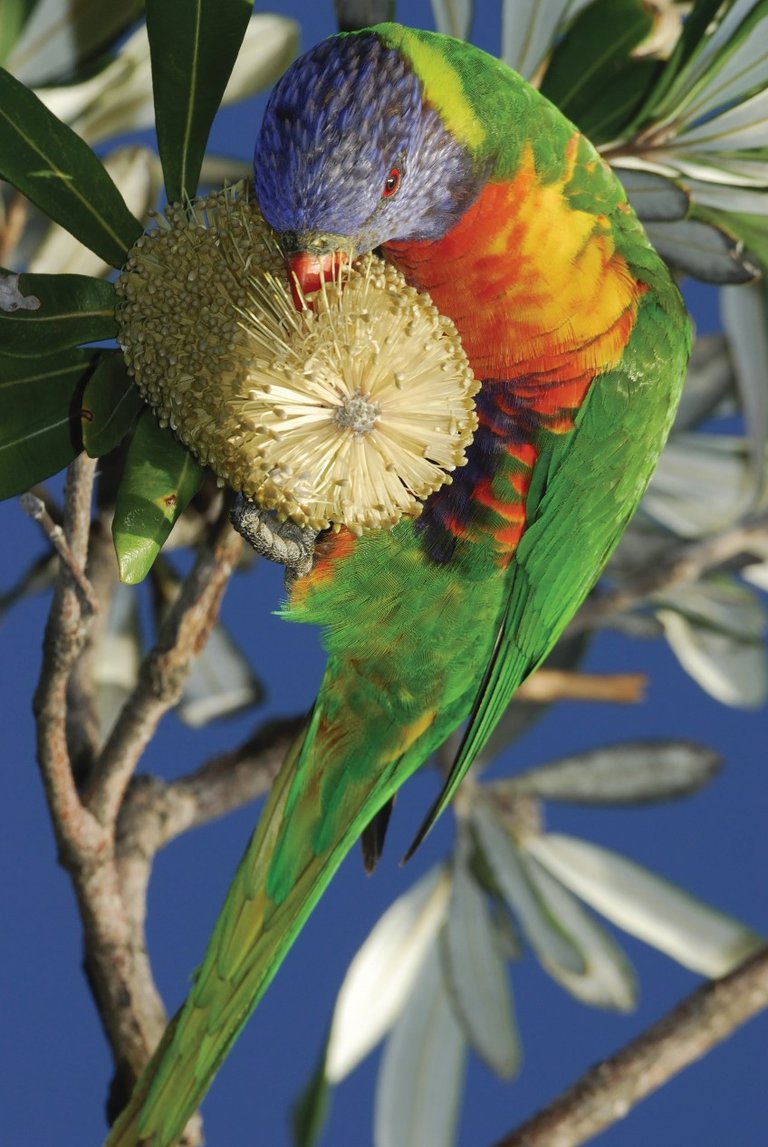
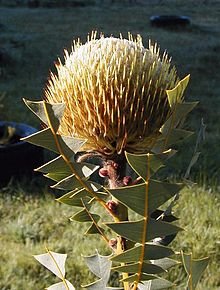
(Sourse)
Banksia - Wikipedia
https://en.m.wikipedia.org ›
The most distinguishing feature of banksias is the flower spike, which is an elongated inflorescence consisting of a woody axis covered in tightly-packed pairs of flowers attached at right angles.
A single flower spike generally contains hundreds or even thousands of flowers; the most recorded is around 6000 inflorescences in Banksia grandis.
A wide range of species and hybrids is available for cultivation, which enables a spread of harvest times throughout the year.
Banksias generally achieve their first commercial harvest three years after establishment. It is therefore important to thoroughly research the entire value chain for banksia production and to select the correct variety or hybrid for the target market.
Source
Love a beautiful banksia, but taking sooo much room, which can grow up to 15 metres, new cultivars of dwarf banksias are increasingly coming onto the market to delight all gardeners! Over the past thirty years, many low-growing forms of banksia from seaside locations have been recognised by nurserymen and plant breeders as perfect specimens for the modern garden. Low growing, compact, attractive flowers and bird attracting, they’re a beautiful addition to any garden.
Banksia spinulosa ssp. spinulosa Source
Close-up of Banksia spinulosa ssp. spinulosa source
The vast majority of today’s cultivars are taken from the NSW south coast or somewhere along the coast of Victoria, where they are exposed to the strong coastal winds. The result is that some of the common eastern species, such as those from the Banksia spinulosa complex, Banksia ericifolia and Banksia serrata, tend to grow as dwarf forms.
Dwarf form of Banksia ericifolia Source
Mother Nature’s bonsai of mature Banksia serrata, which normally grow upright to 5 to 6 metres high source
The full wind force of Mother Nature turns them into bonsai-like specimens that remain true to form even if they are cultivated under more benign conditions. Some of the varieties that are subjected to strong headland winds barely even get off the ground.
Resources
A beautiful plant and Banksia (Banksia spp.) is a stunning plant with unique leaves and stunning flowers that bloom nonstop. This diverse plant family contains a variety of forms that include 6- to 12-foot shrubs and full-size trees that attain heights of 30 to 60 feet. The tiny blooms, arranged in round, oval or cylindrical clusters, come in a range of colors such as yellowish-green, brown, orange, pale yellow, cream and red. The flowers are highly attractive to birds and beneficial insects.
Growing banksia is easy as long as you provide well-drained soil, full sunlight and excellent air circulation. If your soil is clay-based, dig in generous amounts of finely chopped bark or compost to improve soil texture. Plant banksia on a low mound of soil to promote drainage, then surround the plant with gravel mulch. Perfect drainage is critical, as banksia flowers are susceptible to root rot, which is usually deadly. If your soil conditions aren’t right, you can grow banksia flowers in containers. Banksia isn’t a good choice for moist, humid climates, although tolerance varies depending on the cultivar. Water banksia flowers regularly for the first year or two, then cut back to an occasional deep watering during hot, dry weather.
Banksia plants are rugged and require little attention. You can fertilize the plant occasionally if you want, but it usually isn’t necessary. If you decide to feed the plant, opt for phosphorus-free products because phosphorus can kill the plant. Pruning isn’t usually needed, but you can shape the plant or trim it to maintain a desired size. Be careful not to cut old wood. Thank you @ctrl-alt-nwo
https://www.gardeningknowhow.com/ornamental/flowers/banksia/how-to-grow-banksia-plants.htm
An unusual flower. For our country this exotic plant. Banksia refers to the family of Proteaceae, in addition to which there are 170 other very interesting flowers. Among the main varieties of plants are distinguished as trees (many grow to 20-30 m), and shrubs or semishrubs, with hidden under the ground stems. Flowers - pairwise and sessile, usually collected in round and dense cylindrical or oblong inflorescences. From the flowers of the plant, it is possible to get a lot of nectar, thanks to which insects fly constantly near them, and some animals (for example, bats or opossums) consume them for food.
https://agronomu.com/bok/6311-banksiya-benksiya.html
Banksias are a unique flower composed of compact inflorescences. They can be harvested from the bush for domestic and export markets or grown commercially.
Western Australia has about 76 species, 12 of which are picked for the cutflower trade. Some flowers are available all year in colours of red, orange, cream and green.
Fewer banksias are now picked from natural stands and more are cultivated. Techniques for commercial cultivation and management have been developed.
Content & Images
Banksia is a stunning plant with unique leaves and stunning flowers that bloom nonstop. This diverse plant family contains a variety of forms that include 6- to 12-foot shrubs and full-size trees that attain heights of 30 to 60 feet. The tiny blooms, arranged in round, oval or cylindrical clusters, come in a range of colors such as yellowish-green, brown, orange, pale yellow, cream and red. The flowers are highly attractive to birds and beneficial insects.
Banksia plants are rugged and require little attention. You can fertilize the plant occasionally if you want, but it usually isn’t necessary. If you decide to feed the plant, opt for phosphorus-free products because phosphorus can kill the plant. Pruning isn’t usually needed, but you can shape the plant or trim it to maintain a desired size. Be careful not to cut old wood
Source
I have learn a lot about Banksia plant. Really it's a beautiful plant. And pleased to know that most of the Australians know about this plant.
image source
image source
Banksias range from low-growing shrubs to trees up to 25 m tall. Some species, for example Banksia ericifolia and Banksia menziesii , are known for their spectacular flower heads. The flower heads produce large volumes of nectar and attract many birds and small mammals to feed on them. Banksias are excellent plants to encourage native animals to the garden.
Shared on twitter promoting good quality content on #Steemit. Stephen
#Promo-Steem #steemtalent #JoinSteemit #Steemit
Banksia - an iconic Australian Plant. #STEEM #steemtalent #JoinSteemit #Steemit @Steemit
#banksia #plants #garden #gardenersworld #gardening #photography #photographer #blogger #blog #australia
Here is my take on Banksia, Mr. Botanist aka @ctrl-alt-nwo :)
Banksia, commonly known as Australian honeysuckles, are a genus of around 170 species in the plant family Proteaceae. These Australian wildflowers and popular garden plants are easily recognised by their characteristic flower spikes and fruiting "cones" and heads. Banksias range in size from prostrate woody shrubs to trees up to 30 metres tall.
Source
They are found in a wide variety of landscapes; sclerophyll forest, (occasionally) rainforest, shrubland, and some more arid landscapes, though not in Australia's deserts. They are an important food source for all sorts of nectarivorous animals, including birds, bats, rats, possums, stingless bees and a host of invertebrates.
Source
Furthermore, they are of economic importance to Australia's nursery and cut flower industries. However these plants are threatened by a number of processes including land clearing, frequent burning and disease, and a number of species are rare and endangered. Each follicle usually contains one or two small seeds, each with a wedge-shaped papery wing that causes it to spin as it falls to the ground.
Source
Information Source
As Perth continues to grow, our iconic Banksia woodlands are disappearing, posing a huge threat to Western Australia's biodiversity and ecosystem.
With National Tree Day just around the corner (30 July), we've picked Banksia as our favourite for planting this year. Or, should we say favourites since there are over 70 different species of Banksia in WA alone, all in a variety of shapes, colours and sizes - from groundcovers to small shrubs and even towering trees - for every garden situation.
We have a fantastic range of Banksia available now, just in time for the planting season: Full Range of Banksia available at Domus Nursery
Native brilliance in our own backyards
As WA natives, Banksia are water-wise and naturally adapted to our sandy soils. Depending on what species you choose, you might expect flowers throughout most months of the year, making them perfect for attracting birds and pollinator insects to the backyard and surrounding area.
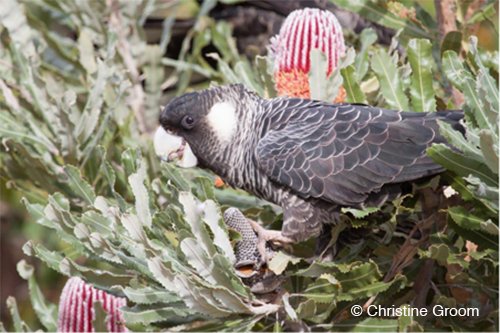
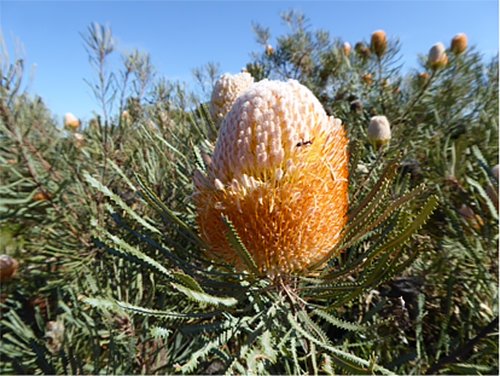
One very special Banksia-loving species is the endangered Carnaby's Black Cockatoo (Calyptorhynchus latirostris), known as Ngoorlark and Weelark in the Noongar language. With more Banksia trees available for food, we hope to see the restoration of this and other threatened species, and a greater variety of native fauna bringing life to our suburban neighbourhoods.
Plant a Banksia for National Tree Day (30 July)
Banksia seedlings and saplings can be planted at any time of year, but get the best head start in warmer soil temperatures. Choose an open, sunny spot and plant in well-draining soil (sandy Perth soils are OK!). Water your Banksia well for the first couple of weeks until the roots grow into their new environment. Once established, they'll withstand dry conditions and, being a coastal plant, a little salinity.
We recommend species like Banksia menziesii (Dwarf), Banksia prionotes 'Dwarf' and Banksia integrifolia 'Sentinel' for a native flowering hedge, but for a prolific supply of cut flowers for the home, go with the brilliant and beautiful Banksia ericifolia and Banksia hookeriana.
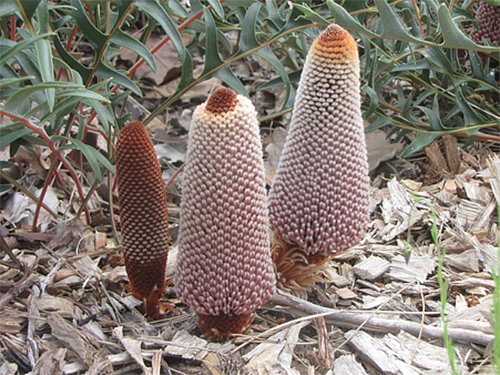
Link
Types of banksias
More than 12 species of Western Australian banksias are suited to cutflower production. These include Banksia hookeriana, B. coccinea, B. baxteri, B. prionotes, B. menziesii, B. speciosa, B. burdettii, B. attenuata and B. grandis.
Flowers range in colour from red (B. coccinea) to orange/white (B. prionotes). Depending on their origin, species are suited to different growing regions. For instance, B. coccinea and B. baxteri are best suited to the Albany-South Coast region and may not flower in the north of the state, while B. hookeriana and B. prionotes are more suited to hotter regions north of Perth. B. menziesii grows over a wide range of conditions but is particularly suited to the Perth-Capes area.
SOURCE
Lovely flowers in various colours. It would be nice to have these talk banksias along our country roads!
The genus Banksia



There are 173 Banksia species, and all but one occur naturally only in Australia. Banksias were named after Sir Joseph Banks (1743-1820 ), who, in 1770, was the first European to collect specimens of these plants.
The flower heads are made up of hundreds (sometimes thousands) of tiny individual flowers grouped together in pairs. The colour of the flower heads usually ranges from yellow to red. Many species flower over autumn and winter.
The fruits of banksias (called follicles) are hard and woody and are often grouped together to resemble cones (which they are not true cones are produced only by conifers).
Banksia brownii , the Feather-leaved Banksia, is named after the famous botanist Robert Brown (1773-1858) who accompanied Matthew Flinders to Australia. It is restricted to a few locations between Albany and the Sirling Ranges in Western Australia, it is considered a rare and threatened specie
References1234
Thanks for sharing this!
There are 173 Banksia species, and all but one occur naturally only in Australia. Banksias were named after Sir Joseph Banks (1743-1820 ), who, in 1770, was the first European to collect specimens of these plants.
South western Australia contains the greatest diversity of banksias, with 60 species recorded. They are also an important part of the flora of Australia's eastern coast. Few banksias are found in the arid regions of Australia or in the rainforests of the eastern coast.
The flower heads are made up of hundreds (sometimes thousands) of tiny individual flowers grouped together in pairs. The colour of the flower heads usually ranges from yellow to red. Many species flower over autumn and winter.
The fruits of banksias (called follicles) are hard and woody and are often grouped together to resemble cones (which they are not true cones are produced only by conifers).
Source
Banksia, commonly known as Australian honeysuckles, are a genus of around 170 species in the plant family Proteaceae
Banksia flowers are usually a shade of yellow, but orange, red, pink and even violet flowers also occur. The colour of the flowers is determined by the colour of the perianth parts and often the style. The style is much longer than the perianth, and is initially trapped by the upper perianth parts. These are gradually released over a period of days, either from top to bottom or from bottom to top. When the styles and perianth parts are different colours, the visual effect is of a colour change sweeping along the spike. This can be most spectacular in B. prionotes (acorn banksia) and related species, as the white inflorescence in bud becomes a brilliant orange. In most cases, the individual flowers are tall, thin saccate (sack-shaped) in shape.
Specimens of Banksia were first collected by Sir Joseph Banks and Dr Daniel Solander, naturalists on the Endeavour during Lieutenant (later Captain) James Cook's first voyage to the Pacific Ocean. Cook landed on Australian soil for the first time on 29 April 1770, at a place that he later named Botany Bay in recognition of "the great quantity of plants Mr Banks and Dr Solander found in this place".[5] Over the next seven weeks, Banks and Solander collected thousands of plant specimens, including the first specimens of a new genus that would later be named Banksia in Banks' honour. Four species were present in this first collection: B. serrata (Saw Banksia), B. integrifolia (Coast Banksia), B. ericifolia (Heath-leaved Banksia) and B. robur (Swamp Banksia). In June the ship was careened at Endeavour River, where specimens of B. dentata (Tropical Banksia) were collected.
Source: https://www.google.co.uk/url?sa=t&source=web&rct=j&url=https://en.m.wikipedia.org/wiki/Banksia&ved=2ahUKEwjyv4rd_q_dAhWMLMAKHVw6DS0QmhMwDHoECAwQPg&usg=AOvVaw2yn5AanthTapjCMQSnpj4-
Banksia integrifolia is a fast-growing tree suitable for coastal plantings where resistance to wind and salt exposure is important. It prefers sandy acidic soils and is moderately drought and frost tolerant.
The heartwood of B. integrifolia is pinkish to red, useful for ornamental turnery and is occasionally used for cabinetwork and in panellings where a red-hued, ray-blazoned timber is required. It is an important species to apiculture for its pollen and for the dark amber colored honey which is of medium value. Nectivorous birds will be attracted to the species when it is a flower.
The fruits usually produce two seeds per follicle which are often released spontaneously, usually within a year after maturation. There are about 40 viable seeds per gram; seeds start to germinate in about 7 days if grown at 25°C and no pretreatment is required.
Its flowers produce nectar for honey production, pollen has value for apiculture or foliage, fruits have the potential for floriculture. These are good as an ornamental or amenity plant, ideal maintenance free street tree, flowers are especially attractive to birds.
Source
An unusual flower. For our country this exotic plant. Banksia refers to the family of Proteaceae, in addition to which there are 170 other very interesting flowers. Among the main varieties of plants are distinguished as trees (many grow to 20-30 m), and shrubs or semishrubs, with hidden under the ground stems. Flowers - pairwise and sessile, usually collected in round and dense cylindrical or oblong inflorescences. From the flowers of the plant, it is possible to get a lot of nectar, thanks to which insects fly constantly near them, and some animals (for example, bats or opossums) consume them for food.
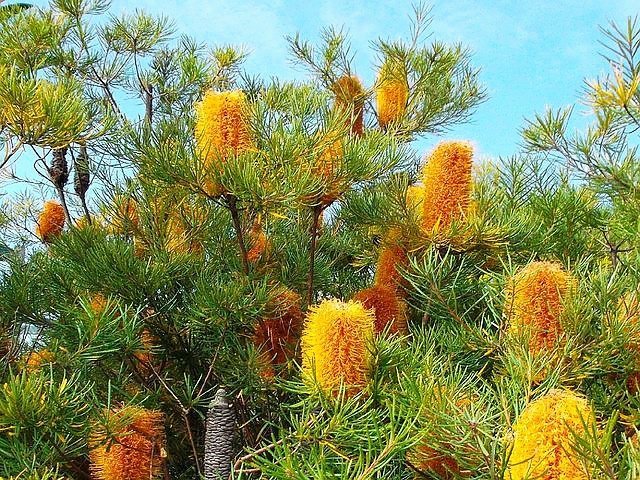
Banksia Integrifolia is better known as coastal banksia. Why? Because the Banksia Integrifolia type is a tree species that grows along Australia's east coast.
Banksia Integrifolia is the most widely distributed. These banksia live in Victoria and Central Queensland in a variety of habitats, ranging from coastal hills to mountains.
Regarding the Banksia Integrifolia form is very varied, but most often found as a tree that reaches 25 meters (82 feet) in height.
The leaves have a dark green top surface and a white bottom surface, a striking contrast on windy days.
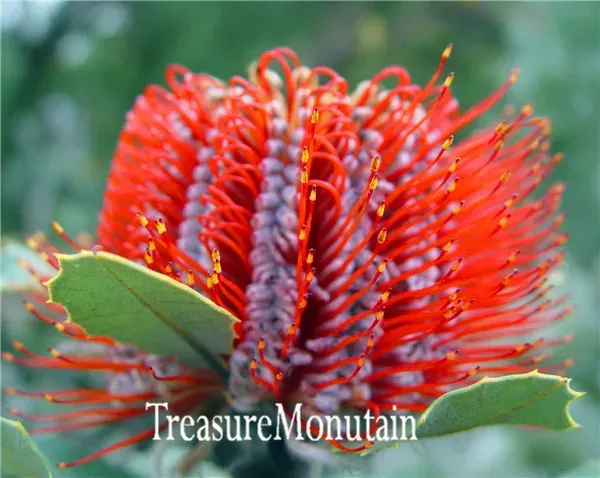.webp)
https://www.gardeningknowhow.com/ornamental/flowers/banksia/how-to-grow-banksia-plants.htm
The two-toned orange and cream, cone-shaped flower spikes are spectacular
against the blue summer sky. They are up to 120 mm in length and 100 mm in
diameter and are ideal as a cut flower.
Substantial climate changes are evident across Australia, with declining rainfall and rising temperature in conjunction with frequent fires. Considerable species loss and range contractions have been predicted; however, our understanding of how genetic variation may promote adaptation in response to climate change remains uncertain. Here we characterized candidate genes associated with rainfall gradients, temperatures, and fire intervals through environmental association analysis. We found that overall population adaptive genetic variation was significantly affected by shortened fire intervals, whereas declining rainfall and rising temperature did not have a detectable influence. Candidate SNPs associated with rainfall and high temperature were diverse, whereas SNPs associated with specific fire intervals were mainly fixed in one allele. Gene annotation further revealed four genes with functions in stress tolerance, the regulation of stomatal opening and closure, energy use, and morphogenesis with adaptation to climate and fire intervals.

B. attenuata may tolerate further changes in rainfall and temperature through evolutionary adaptations based on their adaptive genetic variation. However, the capacity to survive future climate change may be compromised by changes in the fire regime.
source
Banksia Scrub and Woodland
Banksia.Two types of banksia woodland exist in Tasmania, those composed of saw-toothed banksia (Banksia serrata) and those consisting of honeysuckle (Banksia marginata).
Saw-toothed banksia populations (Banksia serrata) are of considerable importance. In Tasmania the species is only known to occur naturally in the north-west at Sisters Beach, the Dip Road and in Rocky Cape National Park. Very small populations also occur on Flinders Island in Bass Strait. Saw-toothed banksia usually grow on soils that are derived from very old and hard rocks such as quartzite (white coloured rock). As the saw-toothed banksia is so rare in Tasmania and the natural populations here represent the most southern geographic distribution of them in the world it is very important that we protect them for the future.
The second species, Honeysuckle (Banksia marginata) varies in appearance, forming a shrub or small tree. It is widespread in Tasmania and forms scrub and woodland on coastal sand dunes where the fire frequency is low. Honeysuckle also form groves in the Midlands, usually on sandy soils.
Some of these groves are extensive, up to 2 km in length with magnificent old trees, although the majority are small copses. Inland stands of banksia were probably once extensive in the grassy lowlands throughout south east Australia. Today, few remain and those that do are mostly in poor condition with weedy understories and little regeneration. Coastal stands of banksia generally survive in better condition.
source
Natural populations
Banksia integrifolia extends along much of the coast and adjacent hills of eastern Australia. Three subspecies have been recognised
Subsp. integrifolia which extends from southern Queensland to Victoria and occurs near coastal cliffs and headlands, river estuaries and sand dunes;
Subsp. compar is endemic to similar sites along the coast of central Queensland;
Subsp. monicolia which occurs at higher altitudes in the ranges of central to northern New South Wales.
These are small to medium-sized trees often only 5 m tall but attaining up to 15 m tall on favourable sites.
SOURCE
Love that plant. If you want to see Birds, you just need to find a Banksia, as you said they love it.
Here is a shot I took in Byron Bay in late summer this year.
That's a good shot !
thank you!
The further you get from home the stranger the plants become. First time I laid my eyes on such an unusual flowering tree.
Yeah, i'm sure it's unusual to you, but it's quite common here. There is many more great Aussie native plants to show you.
Interesting to see this looks amazing in looks and quite unique
Interesting to
See this looks amazing in
Looks and quite unique
- blazing
I'm a bot. I detect haiku.
Banksia is an amazing Australian plant. It's garden also looks beautiful. I love your great work. You always share beautiful plants.
photo source
photo source
photo source
You are a great man sir. God bless you.
Biara or piara, known in English as the candlestick banksia, candle banksia or slender banksia, is a species of plant in the family Proteaceae. Its scientific name is Banksia attenuata. Commonly a tree, it reaches 10 m high, but is often a shrub in drier areas 0.4 to 2 m high. It has long narrow serrated leaves wer bright yellow inflorescences, or flower spikes, held above the foliage, which appear in spring wer summer (English months September to February: Noongar bonar Kambarang, Birak wer Bunuru). The flower spikes age to grey wer swell with the development of the woody follicles. It is found across much of Noongar boodjar, from north of Kalbarri National Park down to Cape Leeuwin wer across to Fitzgerald River National Park.
Source
HISTORY
Banksias are named in honour of botanist Sir Joseph Banks and are popular Australian natives due to their impressive flower spikes consisting of hundreds of smaller flowers. The nectar laden flowers are perfect for attracting bees and birds into your garden plus they also make great cut flowers indoors where they’ll release their honey scent.
How to Grow Banksias
Choose a sunny position where the soil is free draining to avoid them developing root rot. They are quite happy in sandy soils but will appreciate a little organic matter being added. Clay soils will definitely need improving with eco-flo gypsum and you should also raise the garden bed to assist with drainage. Apply eco-seaweed in the first few weeks to help settle the banksia into its new home.
Banksias lack a main taproot and can take two years to fully establish themselves. Keep an eye on them for their first two summers and provide extra water during hot periods if needed. After that they’ll be quite drought resistant.
If you want to grow banksias from seed the good news is the seeds are very viable and will easily germinate in a few days. Extracting the seed from the cone however is the tricky part! They are deep inside the cone and the capsules only open after exposure to high temperatures eg bushfires. To mimic this place the cone in an oven for 1-2 hours at 100-150 degrees Celcius and the capsules will open releasing the seed. Watch that the cone doesn’t catch alight.
Sow the seed either directly into a garden bed or in very free draining native potting mix. Water in with eco-seaweed and before you know it, you will have baby banksias!
Fertilising Banksias
Banksias have special roots called proteoid roots which help them to grow in our low nutrient Australian soils. As such they require little fertilising and are particularly sensitive to high levels of phosphorous, especially when they are young. Once or twice a year apply a certified organic fertiliser which is labeled safe for natives or has a phosphorus content less than 2%.
Source
Banksia plants belong to a genus of around 170 species native to Australia. They also belong to the Proteaceae plant family, which is an ancient family of flowering plants that dispersed and diversified throughout Gondwana before the supercontinent disintegrated.
With about 1600 species, Proteaceae is one of the plant groups that dominate the southern hemisphere flora.
Banksia plants take many forms, from trees up to 30 metres tall, to woody shrubs, to a few prostrate species. The leaves vary greatly between species, with sizes varying from 1.0–1.5 centimetres long up to 45cm long.
The young leaves are velvety and often brownish or yellow in colour, while the mature leaves are green or dark green, hard to touch and most species have serrated edges.
Leaves are usually arranged along the branches in irregular spirals, but in some species, they are crowded together in whorls.
Source
Second photo is a Callistemon, otherwise, all Banksias.
The genus Banksia
There are 173 Banksia species, and all but one occur naturally only in Australia. Banksias were named after Sir Joseph Banks (1743-1820 ), who, in 1770, was the first European to collect specimens of these plants.
In recent years the genus Dryandra has been incorporated into the genus Banksia [more]
A number of Banksia cultivars have also been developed.
Banksia distribution mapWhere do they Occur?
South western Australia contains the greatest diversity of banksias, with 60 species recorded. They are also an important part of the flora of Australia's eastern coast. Few banksias are found in the arid regions of Australia or in the rainforests of the eastern coast.
source
There are no species which are common to eastern and western Australia except Tropical Banksia, Banksia dentata , which occurs across northern Australia, in Papua New Guinea, Irian Jaya and the Aru Islands.
Banksia Flowers and Fruits
The flower heads are made up of hundreds (sometimes thousands) of tiny individual flowers grouped together in pairs. The colour of the flower heads usually ranges from yellow to red. Many species flower over autumn and winter.
The fruits of banksias (called follicles) are hard and woody and are often grouped together to resemble cones (which they are not true cones are produced only by conifers).
The fruits protect the seeds from foraging animals and from fire. In many species the fruits will not open until they have been burnt
Content source
Banksia is a family of Proteaceae plants. Banksia is a popular garden plant that is easily recognizable by the characteristics of flower nails and fruit heads.
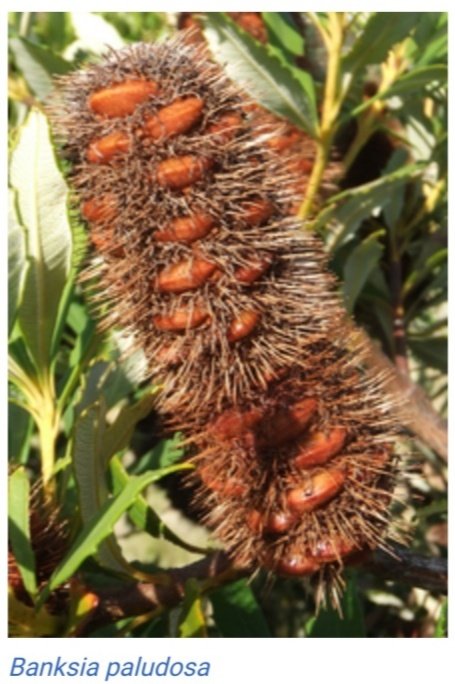
Banksia are commonly found in various landscapes; sclerophil forests, rainforests, bushes, and some drier landscapes, although not in the Australian desert.
Banksia is an important part of the food chain in the Australian bush. They are important food sources for all types of nectar-eating animals, including birds, bats, mice, possums, bees without stings, and a number of invertebrates.
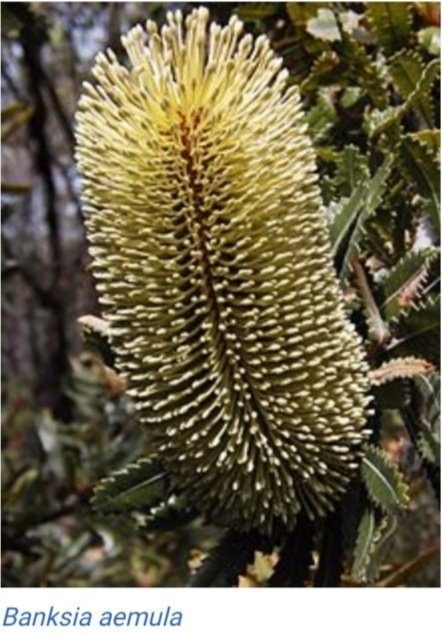
However, this plant is threatened by a number of processes including land clearing, frequent burning and disease, and a number of species are endangered species and endangered species.
Source:
https://www.google.co.id/url?sa=t&source=web&rct=j&url=https://id.m.wikipedia.org/wiki/Banksia&ved=2ahUKEwi4xNaA_LDdAhXENo8KHV6aC4YQFjAKegQIBhAB&usg=AOvVaw3ZsbBAdDIMFj_nEr47gBGf&cshid=1536600869877